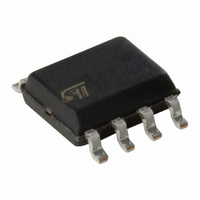M41T81SM6F STMicroelectronics, M41T81SM6F Datasheet - Page 16

M41T81SM6F
Manufacturer Part Number
M41T81SM6F
Description
IC RTC SERIAL W/ALARM 8SOIC
Manufacturer
STMicroelectronics
Type
Clock/Calendar/Alarmr
Datasheet
1.M41T81SM6F.pdf
(32 pages)
Specifications of M41T81SM6F
Memory Size
20B
Time Format
HH:MM:SS:hh (24 hr)
Date Format
YY-MM-DD-dd
Interface
I²C, 2-Wire Serial
Voltage - Supply
2.7 V ~ 5.5 V
Operating Temperature
-40°C ~ 85°C
Mounting Type
Surface Mount
Package / Case
8-SOIC (3.9mm Width)
Function
Clock/Calendar/Alarm/Timer Interrupt
Rtc Memory Size
20 Byte
Supply Voltage (max)
5.5 V
Supply Voltage (min)
2.7 V
Maximum Operating Temperature
+ 85 C
Minimum Operating Temperature
- 40 C
Mounting Style
SMD/SMT
Rtc Bus Interface
Serial (I2C)
Lead Free Status / RoHS Status
Lead free / RoHS Compliant
Other names
497-4684-2
Available stocks
Company
Part Number
Manufacturer
Quantity
Price
Part Number:
M41T81SM6F
Manufacturer:
ST
Quantity:
20 000
Clock operation
Calibrating the clock
16/32
The M41T81S is driven by a quartz controlled oscillator with a nominal frequency of
32,768 Hz. The devices are tested not exceed ±35 ppm (parts per million) oscillator
frequency error at 25
Figure 11 on page
to better than ±2 ppm at 25°C.
The oscillation rate of crystals changes with temperature. The M41T81S design employs
periodic counter correction. The calibration circuit adds or subtracts counts from the
oscillator divider circuit at the divide by 256 stage, as shown in
number of times pulses which are blanked (subtracted, negative calibration) or split (added,
positive calibration) depends upon the value loaded into the five calibration bits found in the
calibration register. Adding counts speeds the clock up, subtracting counts slows the clock
down.
The calibration bits occupy the five lower order bits (D4-D0) in the calibration register 08h.
These bits can be set to represent any value between 0 and 31 in binary form. Bit D5 is a
sign bit; '1' indicates positive calibration, '0' indicates negative calibration. Calibration occurs
within a 64 minute cycle. The first 62 minutes in the cycle may, once per minute, have one
second either shortened by 128 or lengthened by 256 oscillator cycles. If a binary '1' is
loaded into the register, only the first 2 minutes in the 64 minute cycle will be modified; if a
binary 6 is loaded, the first 12 will be affected, and so on.
Therefore, each calibration step has the effect of adding 512 or subtracting 256 oscillator
cycles for every 125,829,120 actual oscillator cycles, that is +4.068 or –2.034 ppm of
adjustment per calibration step in the calibration register (see
Assuming that the oscillator is running at exactly 32,768Hz, each of the 31 increments in the
Calibration byte would represent +10.7 or –5.35 seconds per month which corresponds to a
total range of +5.5 or –2.75 minutes per month.
Two methods are available for ascertaining how much calibration a given M41T81S may
require.
The first involves setting the clock, letting it run for a month and comparing it to a known
accurate reference and recording deviation over a fixed period of time. Calibration values,
including the number of seconds lost or gained in a given period, can be found in application
note AN934, “TIMEKEEPER
ability to calibrate the clock as the environment requires, even if the final product is
packaged in a non-user serviceable enclosure. The designer could provide a simple utility
that accesses the calibration byte.
The second approach is better suited to a manufacturing environment, and involves the use
of the IRQ/FT/OUT/SQW pin. The pin will toggle at 512 Hz, when the stop bit (ST, D7 of
01h) is '0,' the frequency test bit (FT, D6 of 08h) is '1,' the alarm flag enable bit (AFE, D7 of
0Ah) is '0,' and the square wave enable bit (SQWE, D6 of 0Ah) is '0' and the watchdog
register (09h = 0) is reset.
Any deviation from 512 Hz indicates the degree and direction of oscillator frequency shift at
the test temperature. For example, a reading of 512.010124 Hz would indicate a +20 ppm
oscillator frequency error, requiring a –10 (XX001010) to be loaded into the calibration byte
for correction. Note that setting or changing the calibration byte does not affect the
frequency test output frequency.
17). When the calibration circuit is properly employed, accuracy improves
o
C, which equates to about +1.9 to –1.1 minutes per month (see
®
Doc ID 10773 Rev 6
calibration.” This allows the designer to give the end user the
Figure 12 on page
Figure 12 on page
17).
M41T81S
17. The













